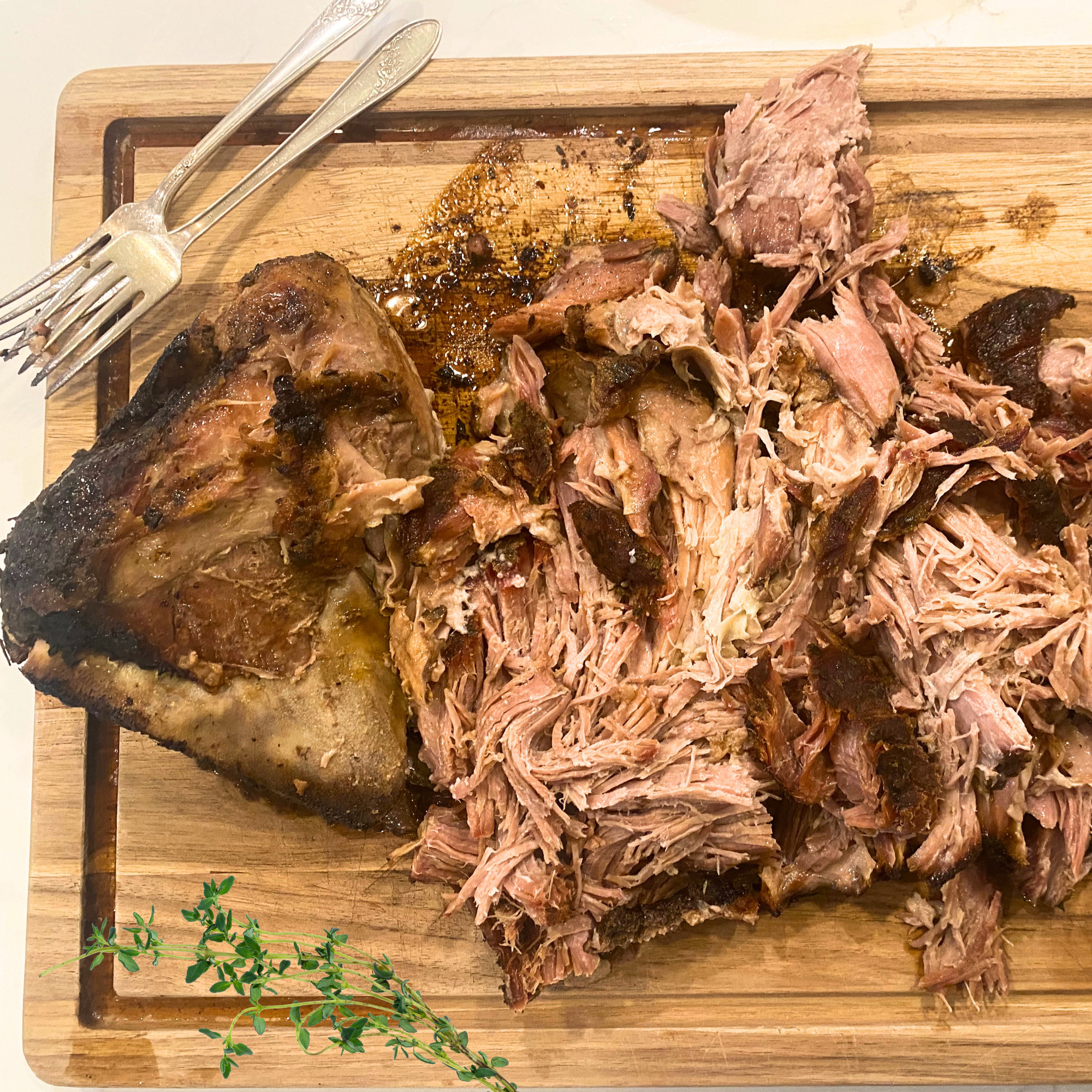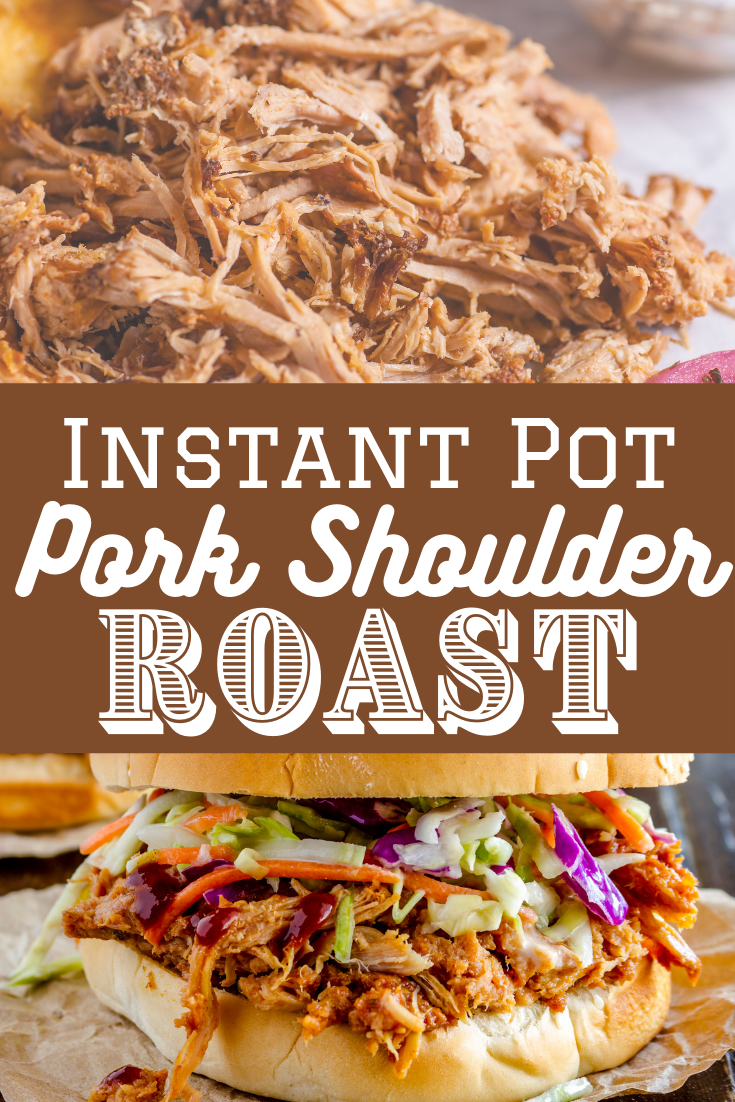Master pork roast perfection, with the proper cook times and internal temperatures for each cut to ensure safe savory meat!

When it comes to cooking pork roasts, achieving both food safety and optimal results is crucial.
Different cuts of pork roast may require varying cooking times and temperatures to ensure they are safe to eat and deliciously tender.
Boneless Pork Loin Roast
Food Safety
- Internal Temperature: Cook pork loin to an internal temperature of 145°F (63°C) on a food thermometer or instant read meat thermometer.
- Resting Time: Let it rest for at least 3 minutes before carving.
Best Results
- Cooking Temperature: Preheat the oven to 325°F (163°C).
- Cooking Time: About 20 minutes per pound, but use a meat thermometer to be sure.
- Desired Internal Temperature: 145°F (63°C).
- Note: Pork loin roast is lean, so be cautious not to overcook to maintain juiciness.
Pork Shoulder (Butt) Roast
Pork Butt or Pork Shoulder roasts become and tender succulent from lower temperature cooking for longer periods of time. These roasts have a fat cap and contain lots of connective tissues that need to break down during the cooking process, and that takes more time.
Food Safety
- Temperature: Cook to an internal temperature of 160°F (71°C).
- Resting Time: Allow it to rest for at least 15-20 minutes before slicing.
Best Results
- Cooking Temperature: Preheat the oven to 225 – 300°F (149°C). Cooking pork shoulder at low temperatures will take a long time, but it’s worth the wait! Slow and low cooking turn out tender succulent pork roast!
- Cooking Time: About 25-30 minutes per pound.
- Desired Internal Temperature: 190 – 200°F (88°C) is the proper temperature for pulled pork. This higher temperature breaks down collagen for a tender result.
- Note: A slow and low cooking method results in more tender meat with Butt Roasts.
Pork Sirloin Roast
Food Safety
- Temperature: Cook to an internal temperature of 145°F (63°C).
- Resting Time: Rest for 3 minutes before serving.
Best Results
- Cooking Temperature: Preheat the oven to 350°F (177°C).
- Cooking Time: About 25-30 minutes per pound.
- Desired Internal Temperature: 145°F (63°C).
- Note: Sirloin roast is relatively lean, so take care not to overcook.

Pork Tenderloin Roast
Food Safety
- Temperature: Cook pork tenderloin to a minimum internal temperature of 145°F (63°C).
- Resting Time: Pork tenderloin is a lean cut of pork that requires rest for 3 minutes.
Best Results
- Cooking Temperature: Preheat the oven to 425°F (218°C).
- Cooking Time: Around 20 minutes per pound.
- Desired Internal Temperature: 145°F (63°C).
- Note: Tenderloin cooks faster, so monitor closely to avoid overcooking.

Hams
Hams are a type of pork roast, but they are generally treated and cooked differently than other pork roasts. These cuts come from the hind leg of a pig and can be sold fresh, cured, or smoked. The specific cooking temperatures and times for hams can vary based on the type of ham and whether it’s fully cooked or raw. Here’s a general guideline:
Fully Cooked Hams
Internal Temperature: 140°F (60°C)
Cooking Method: These hams are already cooked and only need to be reheated. The goal is to reach an internal temperature of 140°F (60°C).

Raw Ham – Fresh Cuts
Internal Temperature: 145°F (63°C) For raw or fresh ham (one that hasn’t been fully cooked), the recommended internal temperature is 145°F (63°C). In this case, the slightly higher temperature is necessary to ensure the pork is fully cooked and safe to eat.
Cooking Method: Uncooked hams need to be cooked to a higher internal temperature than fully cooked hams. Roast at 325°F (163°C) until the internal temperature reaches 145°F (63°C).
Notes
- Glazing: Glaze ham during the last part of the cooking time. Brush ham with a flavorful mixture, of sugar, honey, or fruit juices, to create a shiny, sweet crust.
- Bone-In vs. Boneless: Cooking times may vary based on whether the ham is bone-in or boneless. Bone-in hams may require a bit more time.
- Resting Time: Allow the ham to rest for about 10-15 minutes before carving. This helps the juices redistribute and makes carving easier.
Always refer to the specific cooking instructions provided by the manufacturer or butcher, as different hams may have different recommendations based on their curing or smoking process. Using a meat thermometer is crucial to ensure the ham reaches the recommended internal temperature for safe consumption.
The best internal temperature for a fully cooked ham is 140°F (60°C). This temperature ensures that the ham is heated thoroughly, making it safe to eat while retaining its juiciness and flavor. When reheating a fully cooked ham, it’s crucial to reach this internal temperature without overcooking to prevent dryness.
Whole Cuts of Pork
the cooking temperatures and internal temperatures can vary for different whole cuts of pork. The optimal cooking temperature and internal temperature depend on the specific cut of pork, its thickness, and the desired doneness. Here’s a general guideline for common whole cuts of pork:
Whole Pork Leg – Fresh Ham Roast
Cooking Temperature – Roast at 325°F (163°C).
Internal Temperature (Safe) – Cook to an internal temperature of 145°F (63°C).
For Best Results – For a more tender and shredded texture, you might aim for an internal temperature closer to 190-200°F (88-93°C).
Whole Pork Belly
Cooking Temperature – Roast or slow-cook at various temperatures depending on the recipe.
Internal Temperature (Safe) – Cook to an internal temperature of 145°F (63°C).

Tips for all Pork Roasts
- Room Temperature: Let your raw meat come to room temperature before roasting for a more evenly cooked roast.
- Use a Meat Thermometer: Measure internal temperature from the thickest part of the meat for an accurate reading.
- Resting Time: Allow the roast to rest before carving. This redistributes the juices for a juicier result.
- Seasoning: Consider marinating or seasoning the roast a few hours before cooking for enhanced flavor.
- Pan Searing: For added flavor, season then sear pork roast in a hot pan with a little bit of olive oil before transferring it to the oven.
Pork Roast Temperature Chart
| Pork Cut | Food Safety (Internal Temperature) | Resting Times | Oven Temperatures | Cooking Temperature | Cooking Time | Desired Internal Temperature (Best Results) |
|---|---|---|---|---|---|---|
| Pork Loin Roast | 145°F (63°C) | 3 minutes | Preheat oven to 325°F (163°C) | 20 minutes per pound | Use a meat thermometer | 145°F (63°C) |
| Pork Shoulder – Butt Roast | 160°F (71°C) | 15-20 minutes | Preheat oven to 300°F (149°C) | 25-30 minutes per pound | Use a meat thermometer | 190°F (88°C) for pulled pork |
| Pork Sirloin Roast | 145°F (63°C) | 3 minutes | Preheat oven to 350°F (177°C) | 25-30 minutes per pound | Use a meat thermometer | 145°F (63°C) |
| Pork Tenderloin Roast | 145°F (63°C) | 3 minutes | Preheat oven to 425°F (218°C) | Around 20 minutes per pound | Use a meat thermometer | 145°F (63°C) |
Pork Roast Level of Doneness
Internal temperatures for pork roasts at different levels of doneness:
| Doneness Level | Internal Temperature |
|---|---|
| Rare – Not recommended for Pork | 135°F (57°C) |
| Medium Rare – Correct Temperature for Food Safety | 145°F (63°C) |
| Medium | 160°F (71°C) |
| Medium Well | 165°F (74°C) |
| Well Done Fall Apart | 170°F (77°C) and above 190 – 200 |

Rest Time
The reason some pork roasts only need to rest for a short duration, such as 3 minutes, is primarily related to their specific characteristics and composition.
- Leaner Cuts: Pork roasts, such as those from the loin or tenderloin, are often leaner cuts of meat. These cuts contain less intramuscular fat and connective tissue compared to fattier cuts like pork shoulder. Since there is less fat to retain, the need for an extended resting period to redistribute juices throughout the meat is reduced.
- Moisture Retention: Lean cuts naturally retain more moisture during cooking, and the juices are less prone to collecting in the center of the roast. As a result, the need for extensive resting to redistribute these juices is diminished.
- Tenderness: Lean cuts are generally more tender by nature, so the muscle fibers don’t require as much time to relax through resting. This contributes to the overall tenderness of the meat.
The 3-minute resting time for certain pork roasts is based on the understanding that these leaner cuts have different moisture and tenderness characteristics compared to fattier cuts.
Lean cuts come from muscles that are used less frequently for movement. These muscles generally have less connective tissue and collagen, which are responsible for toughness. In contrast, cuts that come from muscles that are more exercised or worked, such as the shoulder or leg, may have more connective tissue, making them tougher.
The goal is to allow enough time for minimal redistribution of juices and some relaxation of muscle fibers without risking the loss of too much moisture. For larger, fattier cuts, a more extended resting period is often recommended to enhance tenderness and flavor.
Pork Roast Recipes
Sources

About Juliea
Juliea Huffaker is the creator of Farmhouse Harvest, and dedicated to teaching from-scratch cooking, sourdough baking, gardening, and food preservation. With over 25 years of hands-on experience she has preserved hundreds of jars of produce, mastered the art of meats and sourdough baking, and nurtured a thriving organic garden. Her recipes and articles have been featured across the web. And she’s passionate about inspiring others to embrace a simpler, self-sufficient life style.









